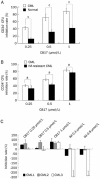Curcumin derivative C817 inhibits proliferation of imatinib-resistant chronic myeloid leukemia cells with wild-type or mutant Bcr-Abl in vitro
- PMID: 24487968
- PMCID: PMC4647898
- DOI: 10.1038/aps.2013.180
Curcumin derivative C817 inhibits proliferation of imatinib-resistant chronic myeloid leukemia cells with wild-type or mutant Bcr-Abl in vitro
Abstract
Aim: To find new kinase inhibitors that overcome the imatinib resistance in treatment of chronic myeloid leukemia (CML), we synthesized C817, a novel derivative of curcumin, and tested its activities against wild-type (WT) and imatinib-resistant mutant Abl kinases, as well as in imatinib-sensitive and resistant CML cells in vitro.
Methods: 32D cells harboring WT or mutant Abl kinases (nucleotide binding P-loop mutants Q252H, Y253F, and imatinib contact residue mutant T315I), as well as K562/G01 cells (with whole Bcr-Abl gene amplication) were tested. Kinase activity was measured using Kinase-Glo Luminescent Kinase Assay Platform in recombinant WT and mutant (Q252H, Y253F, and T315I) Abl kinases. Cell proliferation and apoptosis were examined using MTT assay and flow cytometry, respectively. The phosphorylation levels of Bcr-Abl initiated signaling proteins were analyzed using Western blotting. Colony forming units (CFU) growth and long term culture-initiating cells (LTC-ICs) were used to test the effects of C817 on human leukemia progenitor/stem cells.
Results: C817 potently inhibited both WT and mutant (Q252H, Y253F, and T315I) Abl kinase activities in a non-ATP competitive manner with the values of IC₅₀ at low nanomole levels. In consistent with above results, C817 suppressed the growth of both imatinib-sensitive and resistant CML cells, including wild-type K562, K562/G01, 32D-T315I, 32D-Q252H, and 32D-Y253F cells with the values of IC₅₀ at low micromole levels. C817 (0.5 or 1 μmol/L) dose-dependently inhibited the phosphorylation of Bcr-Abl and downstream proteins STAT-5 and CrkL in imatinib-resistant K562/G01 cells. Furthermore, C817 significantly suppressed CFU growth and LTC-ICs, implicating that C817 could eradiate human leukemia progenitor/stem cells.
Conclusion: C817 is a promising compound for treatment of CML patients with Bcr-Abl kinase domain mutations that confer imatinib resistance.
Figures





Similar articles
-
Inhibition of wild-type and mutant Bcr-Abl by AP23464, a potent ATP-based oncogenic protein kinase inhibitor: implications for CML.Blood. 2004 Oct 15;104(8):2532-9. doi: 10.1182/blood-2004-05-1851. Epub 2004 Jul 15. Blood. 2004. PMID: 15256422
-
Dual inhibition of Bcr-Abl and Hsp90 by C086 potently inhibits the proliferation of imatinib-resistant CML cells.Clin Cancer Res. 2015 Feb 15;21(4):833-43. doi: 10.1158/1078-0432.CCR-13-3317. Epub 2014 Dec 11. Clin Cancer Res. 2015. PMID: 25501124
-
Discovery of a highly potent kinase inhibitor capable of overcoming multiple imatinib-resistant ABL mutants for chronic myeloid leukemia (CML).Eur J Pharmacol. 2021 Apr 15;897:173944. doi: 10.1016/j.ejphar.2021.173944. Epub 2021 Feb 11. Eur J Pharmacol. 2021. PMID: 33581133
-
New Bcr-Abl inhibitors in chronic myeloid leukemia: keeping resistance in check.Expert Opin Investig Drugs. 2008 Jun;17(6):865-78. doi: 10.1517/13543784.17.6.865. Expert Opin Investig Drugs. 2008. PMID: 18491988 Review.
-
Suppression of autophagy by BCR/ABL.Front Biosci (Schol Ed). 2012 Jan 1;4(2):453-60. doi: 10.2741/278. Front Biosci (Schol Ed). 2012. PMID: 22202070 Free PMC article. Review.
Cited by
-
Hsp90 Inhibitors for the Treatment of Chronic Myeloid Leukemia.Leuk Res Treatment. 2015;2015:757694. doi: 10.1155/2015/757694. Epub 2015 Dec 3. Leuk Res Treatment. 2015. PMID: 26770832 Free PMC article. Review.
-
A Subpopulation of the K562 Cells Are Killed by Curcumin Treatment after G2/M Arrest and Mitotic Catastrophe.PLoS One. 2016 Nov 10;11(11):e0165971. doi: 10.1371/journal.pone.0165971. eCollection 2016. PLoS One. 2016. PMID: 27832139 Free PMC article.
-
Effects of resveratrol, curcumin, berberine and other nutraceuticals on aging, cancer development, cancer stem cells and microRNAs.Aging (Albany NY). 2017 Jun 12;9(6):1477-1536. doi: 10.18632/aging.101250. Aging (Albany NY). 2017. PMID: 28611316 Free PMC article. Review.
-
Potential Approaches Versus Approved or Developing Chronic Myeloid Leukemia Therapy.Front Oncol. 2021 Dec 15;11:801779. doi: 10.3389/fonc.2021.801779. eCollection 2021. Front Oncol. 2021. PMID: 34993151 Free PMC article. Review.
-
Hsp90 N- and C-terminal double inhibition synergistically suppresses Bcr-Abl-positive human leukemia cells.Oncotarget. 2017 Feb 7;8(6):10025-10036. doi: 10.18632/oncotarget.14324. Oncotarget. 2017. PMID: 28036294 Free PMC article.
References
-
- 1Druker BJ, Talpaz M, Resta DJ, Peng B, Buchdunger E, Ford JM, et al. Efficacy and safety of a specific inhibitor of the BCR-ABL tyrosine kinase in chronic myeloid leukemia. N Engl J Med 2001; 344: 1031–7. - PubMed
-
- 2Gorre ME, Mohammed M, Ellwood K, Hsu N, Paquette R, Rao PN, et al. Clinical resistance to STI-571 cancer therapy caused by BCR-ABL gene mutation or amplification. Science 2001; 293: 876–80. - PubMed
-
- 3von Bubnoff N, Schneller F, Peschel C, Duyster J. BCR-ABL gene mutations in relation to clinical resistance of Philadelphia-chromosome-positive leukaemia to STI571: a prospective study. Lancet 2002; 359: 487–91. - PubMed
Publication types
MeSH terms
Substances
LinkOut - more resources
Full Text Sources
Other Literature Sources
Medical
Miscellaneous

